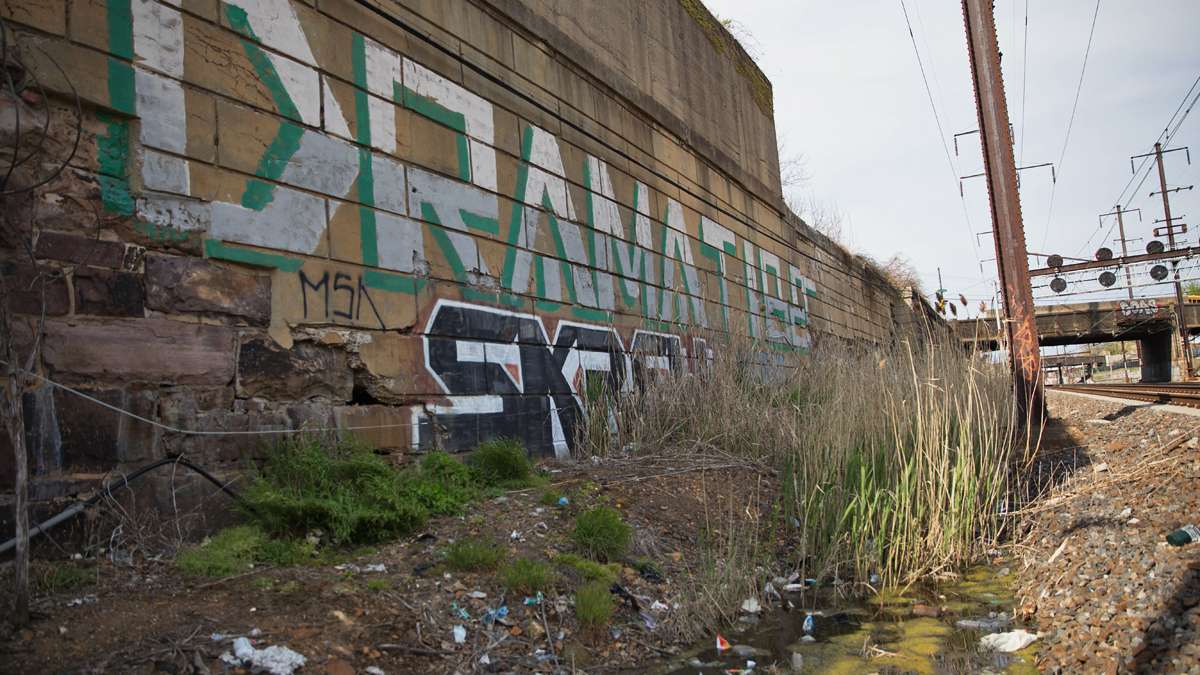Sowing seeds of change, wildflowers along Amtrak corridor

German artist Katharina Grosse sprayed huge swathes of color, and the Pennsylvania Horticultural Society will plant fields of wildflowers, along the rail corridor between 30th Street Station and North Philadelphia Station to draw attention to the need to redevelop the abandoned post-industrial area. (Lindsay Lazarski/WHYY, file)
Before Drew Becher moved to Philadelphia to head the Pennsylvania Horticultural Society, he worked in both New York City and Washington, D.C. He often found himself on the Amtrak train passing through North Philadelphia.
“When you look out the windows of the train, you make your mind up about how well a city is doing, just by those images,” said Becher. “I was shocked by the big disconnect, knowing what the image is going back and forth on the train, and being involved in the city and knowing about all the great things going on here.”
The North Philadelphia rail corridor passes through what used to be the heart of the city’s industrial economy. Now passengers see the crumbling remains of an old way of doing business. Huge, empty factory buildings create abandoned canyons through which the train speeds. Beyond the graffiti-strewn walls are struggling neighborhoods.
Literally putting a gloss on the problem, Philadelphia’s Mural Arts Program brought in the German artist Katharina Grosse to apply large streaks of pure color on those old factories and the surrounding landscape. Called “psychylustro,” it is an abstract concept designed to draw the eye of train passengers.
Becher says the Horticultural Society will also create fields of color — by planting wildflower meadows in vacant lots along the tracks.
Philadelphia Deputy Mayor for Economic Development Alan Greenberger calls these kinds of visual gestures “down payments” toward the ultimate goal: redevelopment. But the rail corridor presents unique challenges to fix itself.
“Those parcels are very linear parcels, because they made sense from a rail perspective,” said Greenberger, noting that modern manufacturing is less dependent on its proximity to rail lines. “The kinds of parcels that are needed now for industry tend not to be long and linear. They tend to be boxier. Those parcels don’t accumulate to that in a shape that makes sense.”
In his office, Greenberger has a map showing the ring of historic manufacturing circling Philadelphia, going clockwise from the Delaware waterfront, down to the Navy Yard, around to the industrial zone along the lower Schuylkill River, up to the North Philadelphia rail corridor. The rail corridor is one of the most challenging.
“Those neighborhoods need more help than simply what happens around the corridor. You’re dealing with a more complex situation,” said Greenberger. “You have many people living close to this — this was a source of jobs for decades, and it is no longer that. You wish that whatever would go back there would provide that work, but it doesn’t fit contemporary standards.”
There is no vision of what to do with the corridor. No master plan exists. Greenberger says a lot of ideas have come from grad students at local universities studying urban planning, but none of those ideas has moved up to a government level.
WHYY is your source for fact-based, in-depth journalism and information. As a nonprofit organization, we rely on financial support from readers like you. Please give today.





